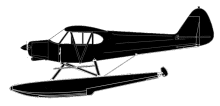
ASN Wikibase Occurrence # 297784
This information is added by users of ASN. Neither ASN nor the Flight Safety Foundation are responsible for the completeness or correctness of this information.
If you feel this information is incomplete or incorrect, you can submit corrected information.
| Date: | Friday 30 August 2019 |
| Time: | 12:10 LT |
| Type: |  Piper PA-18 |
| Owner/operator: | |
| Registration: | N1124 |
| MSN: | 18-3985 |
| Year of manufacture: | 1955 |
| Total airframe hrs: | 3984 hours |
| Engine model: | Lycoming O-320 A1H |
| Fatalities: | Fatalities: 0 / Occupants: 1 |
| Aircraft damage: | Substantial |
| Category: | Accident |
| Location: | Fairbanks, Alaska -
 United States of America United States of America
|
| Phase: | En route |
| Nature: | Private |
| Departure airport: | Fairbanks, AK |
| Fairbanks, AK | |
| Investigating agency: | NTSB |
| Confidence Rating: |
The commercial pilot reported that while in cruise flight in her float-equipped airplane, the engine began to sound "funny," so she elected to return to her destination airport rather than selecting a suitable nearby lake for landing. About 16 minutes later, the engine lost all power and she conducted an emergency landing to a heavily forested area. The airplane sustained substantial damage to the wings.
Examination of the engine revealed that the No. 3 cylinder had separated from the engine's case, but the two No. 3 cylinder hold-down studs were intact and the studs' threads were in relatively good condition; the other cylinder studs were fractured with fretting present on the engine's case. In addition, paint was chipped and broken around the cylinder hold-down nuts and paint was present inside the cylinder stud holes located on the cylinder's flange. The Lycoming overhaul manual states that "All machined bosses should be masked before painting. Do not paint areas under hold-down nuts where torque is required."
Due to the presence of paint inside the cylinder stud holes and broken and chipped paint around the hold-down nuts, it is likely that paint was applied inappropriately under the cylinder hold-down nuts, which would have led to an inaccurate torque reading during assembly, which allowed them to back off over time, resulting in overload failure of the other nuts and separation of the No. 3 cylinder.
Probable Cause: The inappropriate application of paint underneath the engine cylinder hold-down nuts, which resulted in inadequate torque and the subsequent in-flight separation of the No. 3 cylinder, and resulted in a total loss of engine power.
Accident investigation:
 |
|
Sources:
NTSB ANC19LA048
Location
Revision history:
| Date/time | Contributor | Updates |
|---|---|---|
| 15-Oct-2022 08:33 | ASN Update Bot | Added |
Corrections or additions? ... Edit this accident description
The Aviation Safety Network is an exclusive service provided by:


 ©2024 Flight Safety Foundation
©2024 Flight Safety Foundation